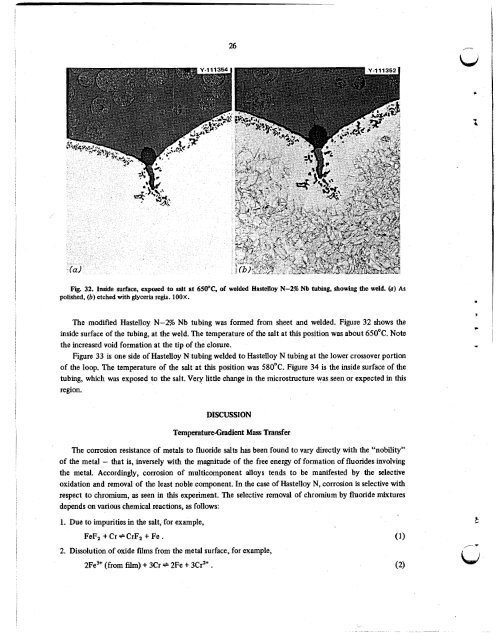Evaluation of hastelloy N alloys after nine years exposure to both a ...
Evaluation of hastelloy N alloys after nine years exposure to both a ...
Evaluation of hastelloy N alloys after nine years exposure to both a ...
You also want an ePaper? Increase the reach of your titles
YUMPU automatically turns print PDFs into web optimized ePapers that Google loves.
26<br />
Fig. 32. Inside surface, exposed <strong>to</strong> salt at 650°C, <strong>of</strong> welded Hastelloy N-2% Nb tubing, showing the weld. (a) As<br />
polished, (b) etched with glyceria regia. lOOX.<br />
The modified Hastelloy N-2% Nb tubing was formed from sheet and welded. Figure 32 shows the<br />
inside surface <strong>of</strong> the tubing, at the weld. The temperature <strong>of</strong> the salt at this position was about 650°C. Note<br />
the increased void formation at the tip <strong>of</strong> the closure.<br />
Figure 33 is one side <strong>of</strong> Hastelloy N tubing welded <strong>to</strong> Hastelloy N tubing at the lower crossover portion<br />
<strong>of</strong> the loop. The temperature <strong>of</strong> the salt at this position was 580°C. Figure 34 is the inside surface <strong>of</strong> the<br />
tubing, which was exposed <strong>to</strong> the salt. Very little change in the microstructure was seen or expected in this<br />
region.<br />
DISCUSSION<br />
Temperature-Gradient Mass Transfer<br />
The corrosion resistance <strong>of</strong> metals <strong>to</strong> fluoride salts has been found <strong>to</strong> vary directly with the “nobility”<br />
<strong>of</strong> the metal - that is, inversely with the magnitude <strong>of</strong> the free energy <strong>of</strong> formation <strong>of</strong> fluorides involving<br />
the metal. Accordingly, corrosion <strong>of</strong> multicomponent <strong>alloys</strong> tends <strong>to</strong> be manifested by the selective<br />
oxidation and removal <strong>of</strong> the least noble component. In the case <strong>of</strong> Hastelloy N, corrosion is selective with<br />
respect <strong>to</strong> chromium, as seen in this experiment. The selective removal <strong>of</strong> chromium by fluoride mixtures<br />
depends on various chemical reactions, as follows:<br />
1. Due <strong>to</strong> impurities in the salt, for example,<br />
FeF2 t Cr + CrF2 t Fe .<br />
2. Dissolution <strong>of</strong> oxide films from the metal surface, for example,<br />
2Fe3+ (from film) t 3Cr + 2Fe t 3Cr2+ .<br />
(1)<br />
(2)



![Review of Molten Salt Reactor Physics Calculations [Disc 2]](https://img.yumpu.com/21979492/1/190x247/review-of-molten-salt-reactor-physics-calculations-disc-2.jpg?quality=85)













